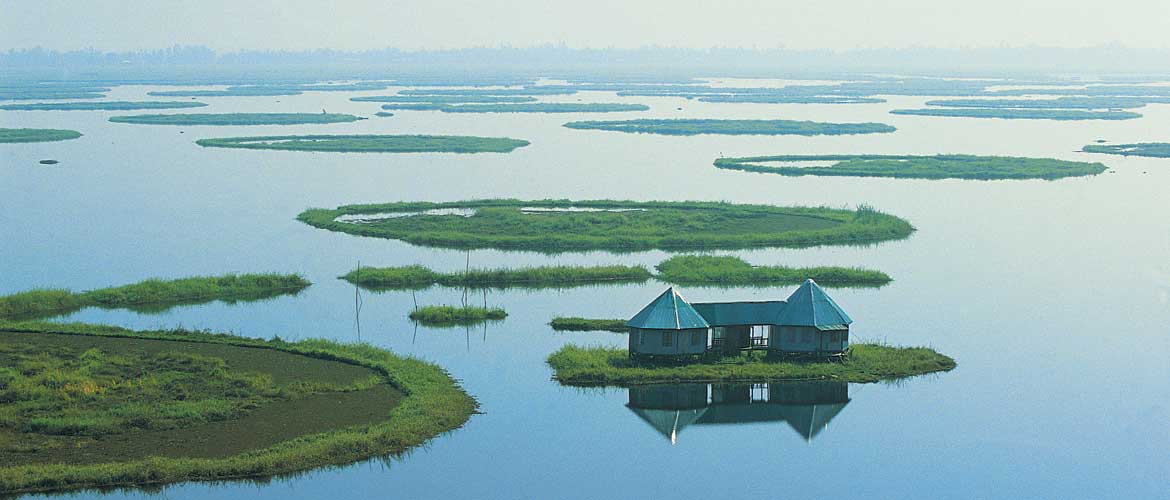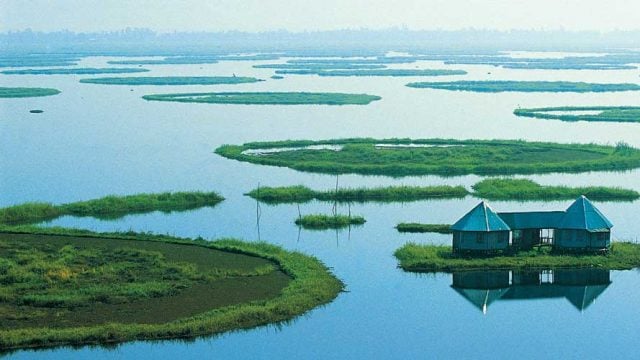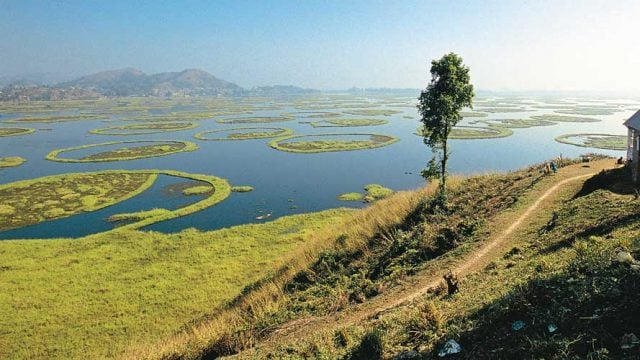The largest freshwater lake of the Northeast never ceases to amaze visitors, no matter the
The lake is referred to as a miniature island sea and a bird’s-eye view of this water body is simply indescribeable. These phumdis are largely made up of weeds and are surrounded by colourful water plants and water chestnuts.
A huge flock of migratory birds descends on the lake as winter sets in. Birdwatching enthusiasts would enjoy a visit at that time.
For enchanting views of this lake, visit the tourist bungalow situated on Sendra island by the bank of the lake. Alternately, you can climb up to the watchtower, located on the hillock of Bebet Ching for a scenic view.

THINGS TO SEE AND DO
Boating
‘Lok’ means stream, and ‘tak’ the end. A boat ride on the beautiful, calm waters of Loktak Lake, which covers an area of about 312sq km, is a perfect way to say goodbye to all your worries. After a boat ride, stop for a snack at the Sendra Tourist Home, and leave for your next destination by taxi.
Boating ₹150 (per person), Taxi ₹1,800
Keibul Lamjao National Park
The world’s only ‘floating’ national park is a popular destination on the travel itineraries of those visiting the Northeast. The park spreads across 40sq km and is actually located on a phumdi, on the southeastern part of the lake. The best time to visit this national park is between November and April.
One can see the endangered brow-antlered deer or sangai, which is indigenous to this area. It is fondly called Manipur’s dancing deer owing to its delicate gait.
Other species of deer seen here include the hog deer, sambar and muntjac. One of the most primitive primates, the slow loris is found in scattered pockets on the hills. Assamese and stump-tailed macaques, and the hoolock gibbon are restricted to the western hills. The rhesus monkey is ubiquitously found around the park. The Indian civet, European otter and wild boar are also found in the national park.
Rare birds also inhabit the national park and are seen congregating at the lake. Waterfowl, the unfailing winter migrants to the lake, are also found here, though their numbers are dec-lining due to an increase of phumdis. The hooded crane is a common sight in the park. The eastern white stork, bamboo partridge and green peafowl are also found here. The black eagle and the shaheen falcon are some of the raptors seen here.

Some of the species of hornbills found here include the brownbacked hornbill, rufousnecked hornbill, wreathed hornbill, the pied hornbill and the great pied hornbill.
Till about 50 years ago, the vegetation on phumdis comprised tou (45 per cent), singut (25 per cent) and khoimom (15 per cent). However, the composition of vegetation has undergone rapid changes. Twenty-four per cent of the vegetation now comprises protein-rich plants, which are grown for food.
WHERE TO STAY
Accommodation is available at the Forest Rest House in Phubala, located close to Loktak Lake. Contact the tourist office in Imphal for details. All other options of stay in the area are very basic. In most places the food has to be arranged by the visitor.
One can also stay at the Sendra Park and Resort. Another stay option is The Classic (Tel: 2443967/ 69, 2445162, Cell: 08974061338; Tariff ₹2,750). It features six rooms and four cottages, a restaurant and it accepts credit cards. It is a sister concern of The Classic Hotel at Imphal.
AROUND LOKTAK LAKE
Moirang (7km)
The largest town in Bishnupur district, Moirang is very close to the Loktak lake, and is one of the main centres of early Meitei folk culture in Manipur.
The town is known for the ancient temple of a pre-hindu deity, Lord Thangjing, and the carvings on the walls tell a mythological love story of ‘Khamba and Thoibi’. The locals celebrate a month-long annual dance festival called Lai Haraoba from mid-May to June, on the temple premises, as a form of worship for their gods.
The town also has an INA museum showcasing relics connected to the Indian National Army and Subhash Chandra Bose’s struggles with the British Empire. There are photographs, letters, badges and other memorabilia of those who served in the INA.

Phubala (13km)
Phubala is located on the bank of the Loktak Lake. Boating and watersports have been introduced here.
The love story of Khamba and Thoibi also has the tale of Phubala Hanuba, an old man after whom this village was named, within it.
Ukhrul (133km)
The highest hill station of Manipur, Ukhrul, is located northeast of Loktak Lake and it offers a panoramic view of surrounding hills. It is a home to the colourful warrior tribe called the Tangkhul Nagas, who are one of the oldest and major tribes of Manipur.
The nearby Siroi Hills are also worth a visit when you are in Ukhrul. The rare Siroi Lily grows on the hilltop. The best time to visit this place is May–June when the flowers are in full bloom.
Barely 15km to the east lies the Khangkui Limestone caves. It is recommended that you start your trip early morning as the journey to the caves includes a 2-km-long trek through a jungle. There are five caves in total, and each of them are different in size and ease of access. Being a relatively less visited site, the Khangkui limestone caves can be easily missed as there is a paucity of directions. Help of locals will be necessary.
Another popular destination very close to Ukhrul is the Nilai Tea Estate. It is a 47km drive north from the town of Ukhrul. The garden is spread on thousands of yards on the Nilai Kaphung hill in Talui village. Owing to the panoramic view it provides of the entire village, along with beautiful mountains and rivers around, the tea garden is slowly becoming a hot spot for picnics.
Moreh (123km)
Moreh is a beautiful hill town located southeast of Loktak Lake on the Indo-Myanmar border, in Chandel District. It is called the commercial capital of the state of Manipur.
Owing to its location, it is also called the gateway to Southeast Asia. The town is famous amongst shopa-holics as one can find absolutely almost anything they can think of, from electronics to fancy clothing and accessories, and almost all house-hold necessities. One can also find a variety of food items here. Products are sold at very cheap rates.
Its location on the border is a big attraction for tourists as they get an opportunity to visit Tamu, a town barely 5km from the border in Myanmar. It is the only town open to foreigners, and can be visited on any day of the year.
Wildlife enthusiasts can visit the Yaingangpokpi Lokchao Wildlife Sanctuary, located close to Moreh on NH39. It is advisable to visit the sanctuary on your way from Imphal, before exploring Moreh.
In terms of flora, bamboo trees are in abundance inside the sanctuary. Regarding fauna, this is home to about 40 species of mammals, including Himalayan mountain bear, hoolock gibbon, wildbear, Indian civet feline, common otter, panther, pangolin and so forth. The types of reptiles living here include viper, krait, cobra, land monitor lizard and several amphibians. A lake inside the sanctuary has almost 90 types of fish.Reaching the sanctuary is easy as taxis are easily available. There are both private and government transport options for tourists.
Where to Stay
Options for overnight halt are available at Moreh, in the Forest Rest House, the Indo-Myanmar Trade Centre Rest House, and the Transit Camp at Wildlife Office. Contact the tourist office in Imphal for details.
FAST FACTS
When to Go Any time of the year, except the monsoon (June–October)
Tourist office
Tourist Info Centre, Directorate of Tourism, Imphal, Tel: 0385-2421046, 2450038, STD code 0385
GETTING THERE
State Manipur
Location Freshwater lake close to Moirang
Distance 40km S of Imphal
Route from Imphal NH150 via Bishnupur, Moirang and Thanga
Air Nearest airport: Tulihal Airport in Imphal (45km/ 1hr) has connections to Delhi, Mumbai, Kolkata and Guwahati. Taxi fare, if you hire one for an overnight journey is ₹3,500–4,000. It is slightly less for a day visit
Moirang
OT Getaway Guides
The Northeast Guide





